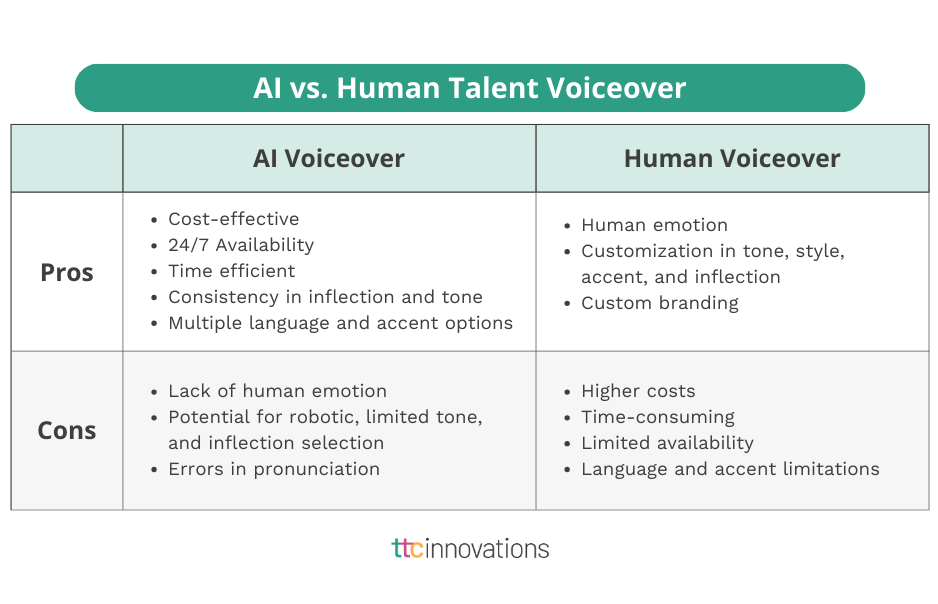When creating your organization’s projects, you now have the option to choose human talent or AI for any voiceover you may need. It is prudent to weigh the pros and cons of both so you make the best decision to ensure your project is well received by the audience and communicates the message you intend.
What is AI Voiceover?
AI voiceover is a technology that uses machine learning algorithms to generate human-like voices. Some options include Murf, Synthesys, WellSaid Labs, Resemble, Amazon Polly, Descript, Listnr, Speechelo, Lovo, Voicemaker, or Revoicer. Some of these are free, while others are not. It is best to try several to decide which one might work best for your organization and project voiceover needs.
What are the pros and cons of AI voiceover?
Let’s unpack some of the pros and cons of AI voiceover!
Pros of AI Voiceover
- Cost-effectiveness. AI tends to be more cost-effective due to using technology and not human talent.
- Efficiency. AI is efficient with quick turnaround times and requires less editing due to the absence of delays for human revisions.
- Consistency. AI ensures there is consistency in voiceover quality and style, allowing you to customize the voice and use it for multiple projects.
- Diversity. AI allows you to utilize multiple languages and accents making it easy to appeal to a global audience.
While there are many pros, there are cons to consider when using technology for your voiceover needs.
Cons of AI Voiceover
- Lack of human emotion.
- Robotic sound with limited tone and inflection.
- Potential errors in pronunciation.
These cons are important to consider as they may decrease audience engagement and not convey the message you intend or bridge the connection you desire.
What is Human Professional Talent Voiceover?
The other voiceover option is human professional talent voiceover. This is the traditional method of using a human’s voice to record voiceover for your project.
What are the pros and cons of Human Professional Talent Voiceover?
Let’s now unpack the pros and cons of human talent voiceover.
Pros of Human Professional Talent Voiceover
- Human emotion. Human Professional Talent Voiceover provides nuance and unique interpretation. Think of Morgan Freedman’s voice as the narrator in documentaries and the voice of God in films or James Earl Jones’ voice as Darth Vader.
- Customize tone, style, accent, and inflection. Using human talent voiceover adds a personalized touch and allows for precise pronunciation.
- Custom branding. Human Professional Talent Voiceover creates a brand people trust and can relate to.
The collaboration with human talent helps you achieve the desired outcome and may increase audience engagement.
Cons of Human Professional Talent Voiceover
- Increased costs.
- Increased production time for voice recording and revisions.
- Limited availability.
- Limited language and accents, usually only one available.
For a quick comparison of AI voiceover and human talent voiceover, review the chart below.

There are pros and cons to both AI and human talent. AI voiceovers still sound robotic and lack human warmth and emotional connection. Human talent voiceovers have a rich emotional connection, but usually has increased production times and costs.
Explore the checklist below to help you decide which might be best for your organization’s voiceover needs.

In navigating the voiceover landscape, consider adopting a hybrid approach that leverages AI’s efficiency and cost-effectiveness alongside the emotional depth and customization capabilities of human talent. This hybrid approach leverages the strengths of both options to keep your project on time, on budget, engaging your audience, and communicating the intended message. As technology evolves and human capabilities continue to shine, finding the right blend will be essential for achieving optimal results in voiceover endeavors.
Whether you decide to use AI or human talent for voiceovers, our team can help! Get a free week of on-demand L&D experts ready to tackle your next project! Book a meeting to get started.







